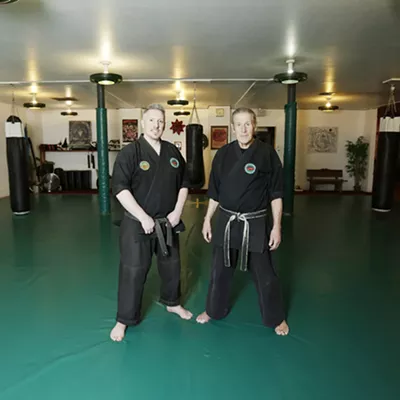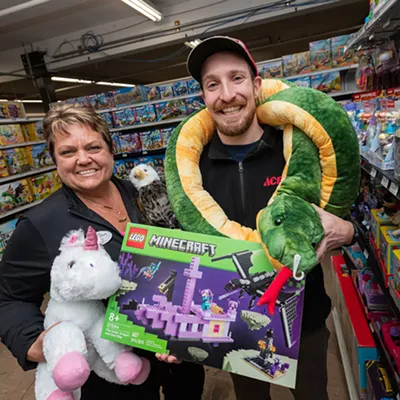We see it and live it anecdotally every day. Addictive screen-based interaction and entertainment, our tendency to drive instead of biking or walking, car-obsessed urban design and a dash of overprotective parenting have surreptitiously conspired to keep both American adults and children close to a charging outlet and safely cocooned from fresh air.
"Human beings have been moving more of their activities indoors since the invention of agriculture and, later, the Industrial Revolution, and through a continuing increase in urbanization," author Richard Louv says via email. "Social and technological changes in the past three decades have accelerated that change, not only in cities but in rural areas as well."
In 2005, in response to these accelerated changes, Louv published Last Child in the Woods, a seminal book in which he coined the term "nature-deficit disorder" — more of a broader societal observation than a specific medical diagnosis. It was intended to identify and capture the insidious consequences of our drift away from green spaces, consequences such as obesity and vitamin D deficiency, depression and anxiety, and an ignorance of the vital functions of natural ecosystems.
Directly or indirectly, Louv's term has since given rise to headline-making, often child-centric movements like No Child Left Inside, "free-range parenting" and "forest bathing." These aim to counter the effects of nature-deficit by encouraging us to unplug from our devices and reconnect more freely with the outdoors.
Ben Baird, who currently heads the board of directors for the Riverside State Park Foundation, is one of the many people who recognized fundamental truths in Last Child in the Woods and was inspired to take action. Six years ago, with the help of later funding from Washington State's No Child Left Inside grant platform, he launched what would become the Outdoor Wilderness Learning (OWL) program at the West Central Community Center in Spokane.
"I always had an inkling on my own that kids needed more outside time, but after I read Last Child in the Woods, that's what guided all my decision-making," he says. The book's idea of unstructured outdoor time was a cornerstone in his approach.
"If we were on a hike, I would design lunchtime so [the kids] were able to stop and explore the environment around them. One of the most successful things we did was our rock and minerals segment. We went up to Mount Spokane, and that whole entire day was focused around exploration. What I found is that the kids not only enjoyed that segment the most, but I would hear from their parents that they were coming back and telling them about each kind of rock that they found in detail. That kind of learning is spurred by unstructured exploration."
Baird also noticed that, as he'd hoped, the effects of OWL activities went beyond stimulating curiosity, even in the program's formative days.
"Just from a three- or four-hour regular outdoor trip, the after-trip dynamics were drastically different than when we would take kids to the movie theater. When we would do outdoor-themed field trips, the kids would come back and there would be a different atmosphere. They were more capable of handling other stressors, whether that was friends or academics," he says.
One girl with a congenital heart disease "began opening up to the world around her" through regular participation in the OWL program, which in turn "allowed her to be more engaged socially and academically." Other children who'd been diagnosed with severe ADHD "would perform better attentively during and after an outdoor event."
While Baird was observing these transformations out in the wild, so to speak, Idaho-based author Sara Zaske was coming across related studies as she researched her recent book Achtung Baby, in which she compares American (fretful and fussing) and German (latitudinal) styles of parenting through the lens of her six years of living in Berlin.
"You can see a difference in the rates of ADHD that are diagnosed in Germany versus America," she says, "which kind of makes you wonder, 'Is there a connection there?' [Germans are] very focused on being outside, being draussen. Kids who are spending time outside have more time to alleviate some of those symptoms of ADHD."
Zaske points to other examples, such as Germans' longer and all-weather school recess or Americans' pervasive fear of stranger danger, as decisive cultural distinctions that can combat or contribute to nature-deficit disorder.
"In America, since we think we have to supervise our kids constantly, going to the playground is kind of a drag. Whereas in Germany, they say, 'Go to the playground,' and the kid goes off by themselves," she says. For Zaske, the solution doesn't necessarily lie in mimicking German parenting approaches outright. It has more to do with curbing our "controlling" impulses and making a return to abandoned norms.
"We as Americans used to have this value. That's what's so confusing. 'Kids need to be aired out' — that's a really old saying, right? The idea was that kids need to be outside every day, and you can see that as a parent. If your kid is inside all day, they start to bounce off the walls. When they get outside, they start to feel better. It's a very human thing, I think."
In 2012, the same year Baird founded the OWL program, Louv notes that the World Conservation Congress of the International Union for Conservation of Nature passed a resolution titled "The Child's Right to Connect with Nature and to a Healthy Environment," a formal gesture that positioned time spent in nature not just as a human need but a human right.
As recognition along those lines grows, a healthier, more active and more satisfying "nature-rich future" is within reach.
"We all can create new natural habitats in and around our homes, schools, neighborhoods, workplaces, cities and suburbs, so that, even in inner cities, our children grow up in nature — not with it, but in it," Louv writes. "The barriers are still there, but I do believe there's more hope in the air, if you look for it."
But It's Boring!
Here are some ways to help kids find
the fun in being outdoors.
• Provide shovels and sifters or mesh screens for an excavation.
• A magnifying glass and jar make catching and examining bugs a lot more fun.
• Rocks are the rockstars of outdoor
entertainment. They can be collected, painted, stacked and balanced, or used with sticks and dirt for building.
• A scavenger hunt — collecting items for young kids or photographing things with phones for older kids and teens — adds excitement while keeping things friendly.
— ANNE McGREGOR




















